#please do more research than reading what 1 (one) hyperfixated idiot put together on a Tumblr post
Explore tagged Tumblr posts
Note
My first pen was a Pilot Metro Retro. And was promptly broke by an E-2 I let borrow it to sign paperwork (i kept the cap so he would have to give it back, but alas). And then a couple years later I jumped to a TWSBI Vac700 Iris. Anyway, i have a few different pens, but I havent found even a basic instruction on how to tune tines or maintain them besides washing them out with distilled water. And suggestions?
Hi there! Sorry about your Metro, and hope you're happy with the TWSBI! I once let someone borrow my Décimo and they... mangled it. Heartbreaking! I was eventually able to fix it, but it took some doing, and it was also a last ditch effort -- I was already fully prepared to dish out the money for a brand new nib unit, so I figured there was no harm in trying.
I'll get to the easy stuff first: if your fountain pen is writing OK, it doesn't really require more maintenance than a good flush every now and then. You don't even have to use distilled water (unless the water in your area is like, exceedingly mineral-heavy) -- plain tap water and regular dish soap will do just fine.
As for nib tuning/readjustments, they are not part of a pen's general maintenance. Readjustments are done if there's a problem with how your pen is writing, and personally I view nib tuning as something done to improve the experience to the user -- mostly to smooth a scratchy nib.
Here's the short answer as to why info on making these adjustments is a little less widespread (though still relatively easy to find):
1) While often simple, these alterations can be a bit fiddly, and it's very easy to irreparably damage your pen.
2) These alterations, but especially tuning/otherwise modifying your nib/feed, will almost certainly automatically void your pen's warranty.
Keep that in mind if you decide to undertake any tuning -- it is always at your own (and your pen's) risk.
That's the short of it! For the (much, much) longer version, as always, see below the cut!
sorry this one took so long, I got really, really into it and it is stupidly long adalskjadhls
So, first things first. Your pen writes completely fine, you wash it every now and then or whenever you're changing inks, and have an overall pleasurable experience writing with it.
Congrats! Nothing else needs to be done. Enjoy your pen.
Now, let's say your pen isn't writing completely fine. Maybe it's skipping, maybe it feels scratchy, maybe it's laying down too much ink or not enough.
Before you go straight to tuning your nib, the first thing you do is: you clean it.
"But Nara, I already cleaned it." Clean it again. You'd be amazed how often a more thorough flush fixes simple flow problems -- do it with dish soap if you used only water the second time.
The next step? Try a different ink, if you have some. Then, try some different paper. It's good to have a paper/ink combo that you're familiar with to use as a standard. I like to use a Rhodia No. 19 Dot Pad and Waterman Serenity Blue to test all of my pens -- nearly every pen I buy writes an 'inauguration' page with that exact combination.
If your pen is a cartridge/converter, always make sure the cartridge or converter is the right fit and that it's seated properly. It should fit securely without a ton of pressure -- if you can basically bop it off without trying, it's probably the wrong fit. If the converter provided to you by the retailer doesn't fit, contact them -- maybe you got a defective pen.
Alright, so you've done all of the above, but your pen is still writing funky or not at all. Now it's time to take a closer look at the nib.
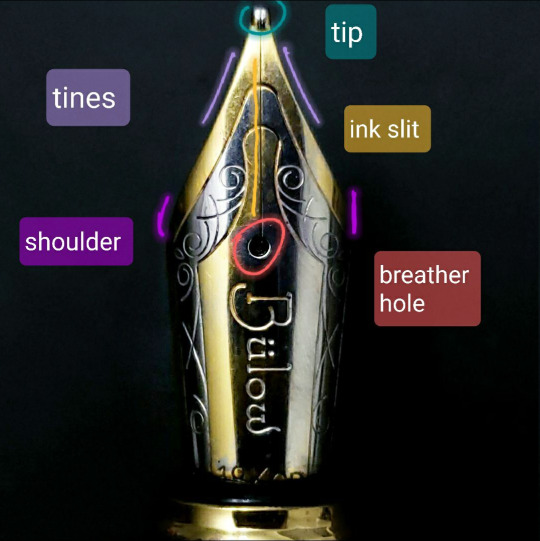
Enjoy this expertly made reference image I made on my phone before I realized I could just link you to a better one.
Before you start researching how to tune/grind your nib, let's check the nib and feed alignment -- the feed is what allows the ink to travel from reservoir to paper, and if cleaning your pen hasn't solved the problem, there's a good chance it is probably not seated correctly.
Here's what you should check for:
1) Make sure your feed is flush to the underside of your nib
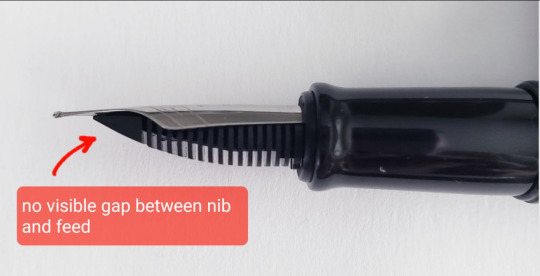
If there's a major gap between the underside of your nib and the top of the feed (where the ink channel is), the ink simply can't get to where it needs to be (i.e. the tip of the nib). I
If there is a major gap, you can check if your nib and feed are seated correctly in the nib section. This depends a little bit on the pen and the model, but most of the time, you can try grasping nib and feed together and gently pushing down. Remember to never grab your nib by the shoulders/tines, as that will most likely ruin it.
2) Make sure your feed is properly centered with the nib.
This is easier to check if your pen has a breather hole, which most of them do. Basically, check to see if the ink channel at the top of your feed (you can see it through the breather hole) lines up with the ink slit. Here's a good example:
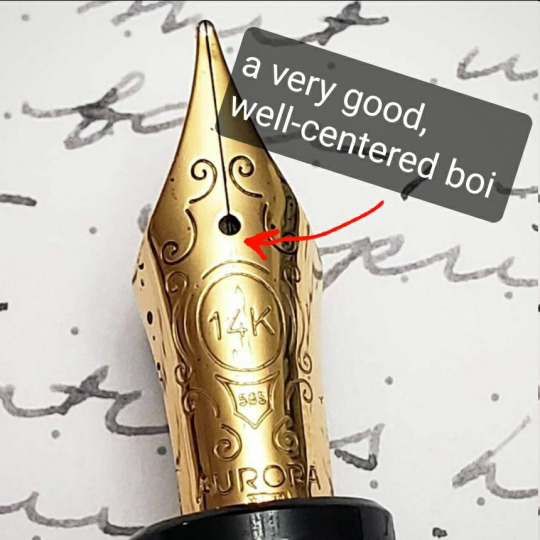
And here are... not so good ones. Coincidentally, both on Conklin pens.
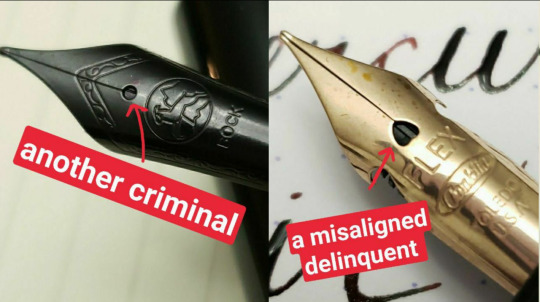
This is usually a simple fit -- sometimes you can gently wriggle it back in place. Other times, you need to remove the nib and feed from the collar (basically the plastic thing that holds the nib unit together) or they are friction fit to the section altogether (like in the Lamy AL-Star). Do a bit of research on your pen model before you try disassembling it.
Feed is centered? All good to go? OK, now we move on to checking the metalworks, so to speak. I recommend using a magnifying glass or loupe for this part. Here's the one I use.
4) Check your tines for a) factory oopsies and b) misalignment.
Here's an example of tines that were just... cut very wrong (sorry for poo-poo pic quality, but you should be able to see the tine on the right just... ain't right)
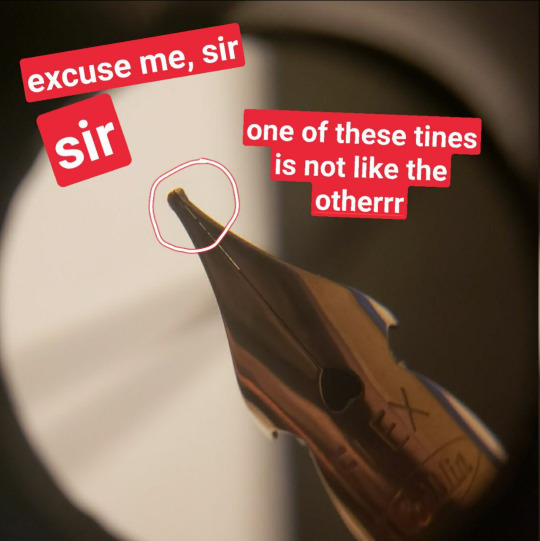
In the case above, contact your retailer. I noticed this one before even inking my pen, but they should cover a replacement regardless.
DISCLAIMER: all adjustments from here on out may void your pen's warranty.
(maybe not a simple realignment, but don't risk it, or ask your retailer before you try anything).
Here's an example of slightly misaligned tines (ON THE SAME PEN AFTER EXCHANGE BTW).
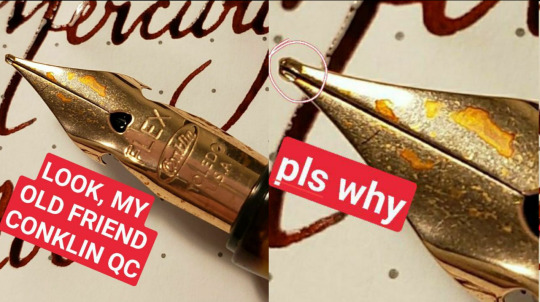
I stupidly didn't get pictures of my Décimo or the Duragraph above looking straight at nib pointing up -- you could actually see one of the tines sloping slightly downward. That causes unbearable (to me) scratchiness and can tear off paper fibers. No fun.
There are better examples from JetPens' Fountain Pen Troubleshooting Guide (which you should absolutely check out!)
You can fix misaligned tines yourself. It requires patience, a little pressure, and a lot of finesse not to overdo it. You can manually bend the tines back into place, but before you try it yourself, I recommend going to YouTube to see how other pen people do it. My method is similar to this one, but there are several others. You can use your fingernail to push it down, just be very careful with how much force you use.
The one method I personally don't recommend is, ironically, the one JetPens recommend on their guide. It might work just fine, but I just think it is way too easy to overdo it and get splayed tines or create a major gap between nib and feed.
OK, seems like the tines on your pen are fine? Time to...
5) Check the distance between your tines.
Your tines should, ideally, be juuust a hair apart-- only enough for the ink and capillary action do their thing. They shouldn't be touching, since that would hinder ink flow, but there should not be a gulf of distance between them either. Let's revisit another Conklin
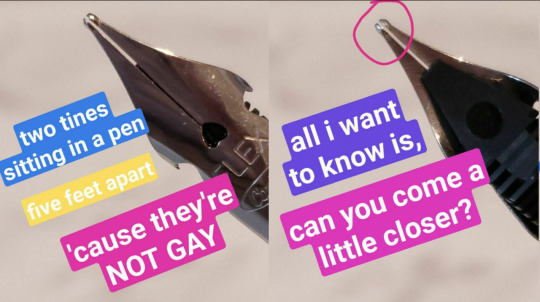
Yay. Fun.
This is also fairly simple to fix, but again: you have to be delicate about it. I manually manipulate my tines into position and kind of go by feel by now, always testing and checking with my loupe. Here's how PenBoyRoy does it:
youtube
Again, there are many different methods, and you will often hear different things from different pen people. It's down to preference and what works for you!
OK, now we've gone through an odyssey of troubleshooting (I AM SO SORRY), let's talk about nib tuning.
Yet another disclaimer: doing anything I describe below will 100% void your pen's warranty.
Tuning your nib isn't necessarily fixing it. It certainly can, if you've done pretty much all of the above and everything looks fine but the pen isn't writing the way you want it to. I use it to smooth down pens that are technically writing OK, but the experience of writing with them isn't entirely pleasant for me.
Essentially, you're using a rougher surface to basically... 'sand down' your nib. There's a wide variety of techniques (from using a rough paper bag all the way to actual fine-grit sanding blocks), but the most important detail you need to remember is you're removing tipping material (however little).
While tuning your nibs isn't necessarily hard, it's very, very easy to overdo it, and that will cause pretty much irreparable damage. If tuning nibs is something you're interested in, practice on inexpensive pens first -- I practiced on ye olde Pilot Varsity.
The Varsity is great to practice tuning because 1) it's super cheap, so even if you fuck it up completely, it's not the end of the world. 2) It has a medium tip.
The bigger the tip = the more tipping material = more room for error.
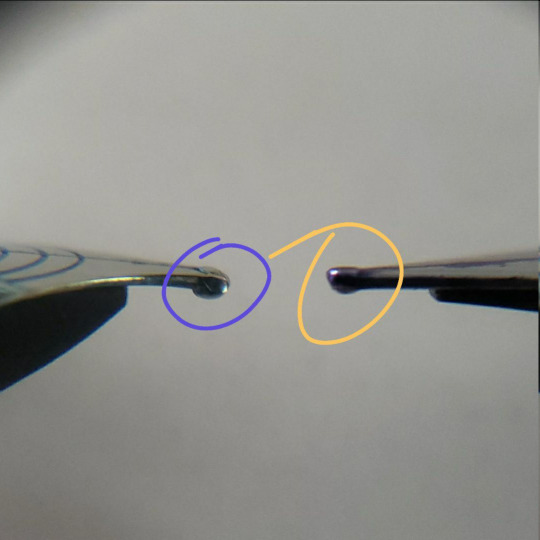
I mainly use two things to tune my pens: micromesh and mylar paper, which are both super fine abrasives. Goulet (and other pen retailers) sell entire nib-tuning kits with everything you might need to get started, but here's my own (plus a few extras that may look scary, but trust me, you don't need all of this):
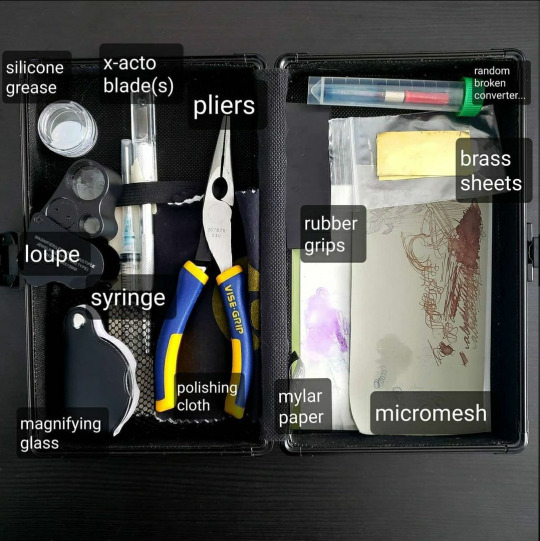
In my pen kit above, you can see my newer sheets of micromesh and mylar and the scribbles I use to tune my nibs. I hold the pen the way I normally would when writing with it, and scribble over the abrasive, but I don't do it randomly. Figure 8s are usually the go-to for simple tuning; you can also go a particular direction if you know exactly which area of your nib needs to be smoothed.
Again, even micromesh and mylar paper (particularly the latter) are incredibly fine abrasives, it is still very easy to overdo it. I have fucked up nibs before, mostly on my practice pens, but also on a not-super-cheap pen, and I had to buy a whole new nib unit.
So, like I said, possible? Very! Simple? Sure! Finicky? Hell yeah.
Side note: tuning a nib is mostly just making it write more smoothly. If you'd like to change the shape of the tipping material entirely (and thus create line variation), that is totally something that can be done!
It is called nib grinding, and it is better left to the professionals, but it is super cool!
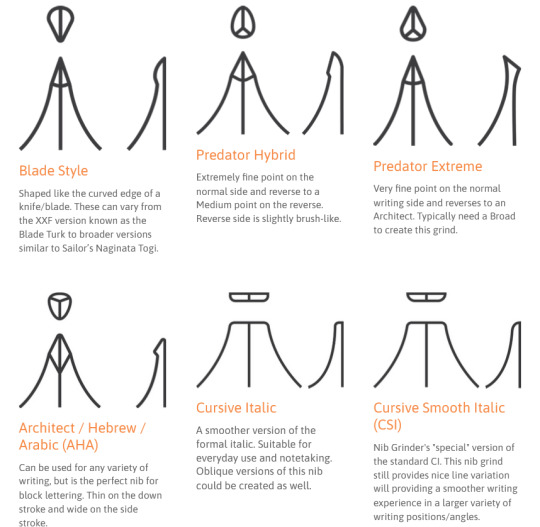
pOK, I didn't quite mean to go into a full nib troubleshooting post, but I should have known my brain could not be stopped. Hopefully, this (extremely) long-winded, tangent-riddled descent into the rabbit hole was at least a little bit useful!
Thanks for dropping by!
#soulofkeys#ask naralanis and maybe she will deign to respond#fountain pen#pen asks#nara rambles#and holy shit how she rambles#I AM SORRY I COULD NOT HELP MYSELF#anyway#have fun I guess?#also#please do more research than reading what 1 (one) hyperfixated idiot put together on a Tumblr post#I avidly encourage it#pen talk
18 notes
·
View notes